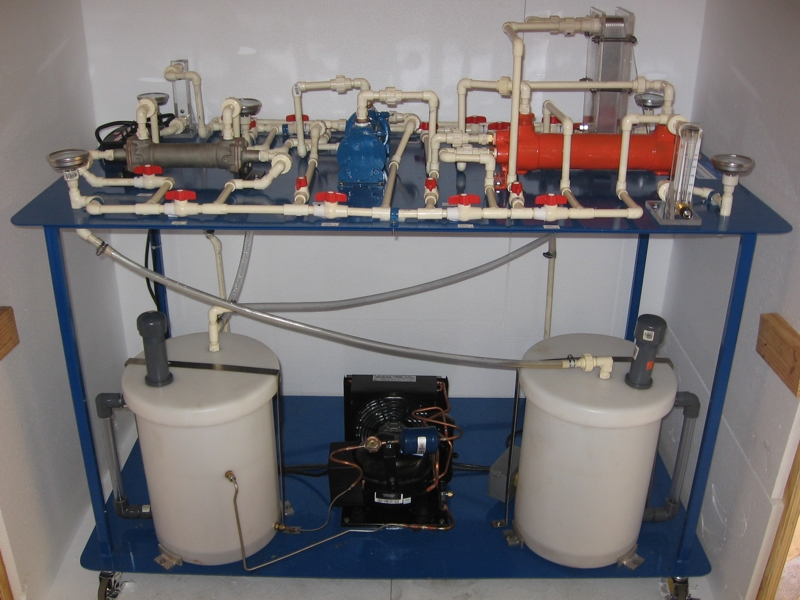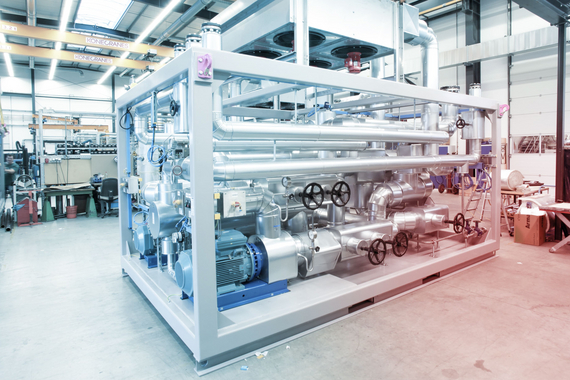DVS Heat Transfer Systems: The Future of Energy-Efficient Industrial Heating Solutions
Exploring the Conveniences and Applications of Heat Transfer Systems in Modern Industry
Heat transfer systems play a necessary function in modern sector. They include various devices such as convection, radiation, and conduction, each adding to effective thermal administration. Industries like manufacturing and aerospace benefit significantly from these systems. As developments continue, the assimilation of cutting-edge products and innovations assures to boost energy efficiency. This advancement increases essential questions regarding the future ramifications for sustainability and operational expenses across numerous fields. What exists ahead in this recurring improvement?
Comprehending Heat Transfer Principles
Heat transfer principles are basic to the operation of numerous industrial systems. These concepts encompass the devices of radiation, transmission, and convection, each playing an essential role in managing thermal power. Understanding transmission includes evaluating exactly how Heat relocates through strong products, while convection concern Heat transfer in fluids, driven by liquid motion. Radiation, unique from the other two, includes energy transfer with electro-magnetic waves. The effectiveness of Heat transfer effects system efficiency, power consumption, and total productivity. Efficient thermal administration is essential in processes such as Heat, air conditioning, and home heating recuperation. By mastering these principles, sectors can maximize their procedures, minimize power expenses, and boost tools durability, consequently adding to a more sustainable and effective commercial landscape.
Key Types of Heat Transfer Solutions
While different markets make use of Heat transfer systems for diverse applications, numerous key types stick out as a result of their particular functions and performances. The most usual kinds consist of convection, radiation, and conduction systems. Conduction systems transfer Heat through direct contact between products, making them reliable in solid-state applications. Convection systems, on the various other hand, use fluid movement to transfer Heat, ideal for home heating or cooling down gases and liquids. Radiation systems run without a tool, counting on electromagnetic waves to move Heat, ideal for high-temperature atmospheres. Each kind serves unique functions, enabling markets to tailor their Heat transfer services based upon operational demands, power effectiveness, and cost-effectiveness. Comprehending these systems is crucial for maximizing performance in various commercial settings.
Industrial Applications of Heat Transfer Technologies
The application of Heat transfer innovations in industry plays an important role in boosting energy performance and maximizing processes. DVS Heat Transfer Systems. By executing advanced Heat exchange systems, companies can greatly lower their environmental influence while boosting general efficiency. This assimilation not only promotes sustainability but additionally lines up with modern governing and customer needs for greener methods
Energy Effectiveness Improvements
As industries increasingly prioritize sustainability, power efficiency renovations in Heat transfer modern technologies have come to be necessary for decreasing functional expenses and ecological impact. Improved Heat exchangers, as an example, use advanced materials and designs to take full advantage of thermal performance while reducing energy intake. Moreover, integrating variable rate drives in pumping systems allows for far better control of fluid flow, leading to considerable power savings. The execution of clever sensors and automation offers real-time tracking, making it possible for changes that maximize energy use. Furthermore, waste Heat recuperation systems record excess thermal power, transforming it right into useful power. These developments not only enhance energy effectiveness however additionally add to an extra lasting commercial landscape by decreasing greenhouse gas exhausts and supporting conformity with ecological laws.
Process Optimization Techniques
Refine optimization methods are critical in enhancing the efficiency and effectiveness of Heat transfer technologies in commercial applications. These techniques involve refining processes to make the most of Heat transfer efficiency while decreasing power consumption and operational costs. Methods such as computational liquid characteristics (CFD) modeling permit engineers to analyze and simulate Heat transfer scenarios, identifying locations for renovation. Additionally, real-time surveillance systems can provide beneficial information on temperature level gradients and circulation prices, allowing adjustments that maximize performance. Moreover, executing innovative control approaches, such as predictive analytics, can enhance system responsiveness to differing operational needs. By applying these optimization techniques, industries can achieve higher thermal performance, reduced downtime, and boosted product top quality, eventually leading to enhanced competition in the market.

Ecological Impact Decrease
While industrial Heat transfer technologies are essential for functional performance, their application likewise presents chances for substantial ecological influence reduction. By enhancing power efficiency, these systems lessen gas intake, leading to reduced greenhouse gas emissions. Progressed Heat exchangers can recover waste Heat, rerouting it to preheat incoming liquids, therefore decreasing power demands. In enhancement, the integration of Heat transfer technologies in renewable resource systems, such as solar thermal and geothermal applications, supports the shift to lasting techniques. Industries that use these modern technologies also take advantage of lowered functional costs and enhanced regulative conformity. Overall, the strategic application of Heat transfer systems not just reinforces efficiency but likewise fosters a more sustainable commercial landscape, adding to global environmental goals.
Advantages of Efficient Heat Transfer Systems
Effective Heat transfer systems provide considerable advantages in modern industry, primarily through improved energy effectiveness and expense reduction. By optimizing thermal management, these systems minimize power waste, leading to lower operational expenses (DVS Heat Transfer Systems). Services can achieve higher sustainability and improved profitability.

Power Efficiency Improvements
As industries progressively focus on sustainability and cost-effectiveness, power performance enhancements in Heat transfer systems have actually become a crucial focus. Enhanced effectiveness in these systems causes minimized power intake, making it possible for centers to run even more sustainably. By maximizing Heat transfer approaches, sectors can decrease waste Heat and attain much better thermal administration, significantly reducing their environmental impact. Advances in technologies such as Heat exchangers and insulation products add to improved performance and reliability. In addition, implementing energy-efficient Heat transfer options not only supports compliance read the article with governing criteria but also fosters a society of technology within companies. Inevitably, these enhancements are vital in aligning commercial operations with international power conservation objectives, leading the way for a more lasting future in manufacturing and handling markets.
Cost Decrease Opportunities
By enhancing Heat transfer systems, markets can disclose considerable cost reduction opportunities that boost their bottom line. Reliable Heat transfer lowers energy intake, resulting in reduced utility expenses and reducing operational expenditures. Furthermore, improved system efficiency decreases the requirement for maintenance and repair work, additionally saving prices gradually. Boosted Heat transfer can additionally extend tools lifespan, enabling business to postpone funding expenses on replacements. Additionally, waste Heat recovery systems can change excess Heat right into useful energy, better driving down expenses. These systems not just streamline processes yet likewise add to sustainability campaigns, placing companies favorably in a significantly eco-conscious market. On the whole, the monetary advantages of reliable Heat transfer systems are significant and vital for competitive advantage.
Developments in Heat Transfer Solutions
Just how can modern industry enhance its operations through innovative Heat transfer solutions? By adopting sophisticated materials and innovations, markets can considerably boost thermal performance and efficiency. Advancements such as nanofluids, which improve Heat transfer abilities past standard liquids, and stage modification materials that keep and release thermal energy, are gaining grip. Furthermore, the combination of clever sensors and IoT gadgets permits for real-time monitoring and optimization of Heat transfer processes, minimizing waste and enhancing system responsiveness. Additive manufacturing strategies allow the creation of more complicated Heat exchangers that make best use of surface location while minimizing product use. Collectively, these innovations drive functional efficiency and produce competitive benefits in numerous fields, consisting of aerospace, power, and manufacturing.
The Duty of Heat Transfer in Sustainability Efforts
While the press for sustainability continues to improve industries, the duty of Heat transfer innovations comes to be increasingly crucial in achieving environmental objectives. Effective Heat transfer systems promote energy effectiveness by enhancing thermal administration in various processes, substantially decreasing power consumption and greenhouse gas discharges. Advanced Heat exchangers are used in commercial applications to reclaim waste Heat, thereby reducing power waste. In addition, developments such as stage adjustment materials improve thermal storage, adding to renewable resource integration. The adoption of lasting liquids in Heat transfer systems can reduce ecological influence. By focusing on efficient Heat transfer, markets not just boost functional efficiency yet likewise line up with international view it now sustainability campaigns, cultivating a cleaner, more sustainable future.
Frequently Asked Concerns
How Do Heat Transfer Equipments Influence Energy Costs in Manufacturing?
Heat go to my site transfer systems noticeably affect power prices in production by boosting performance, lowering waste, and optimizing thermal management. These improvements lead to decrease functional costs, eventually benefiting overall productivity and profitability in industrial procedures.
What Upkeep Is Needed for Heat Transfer Equipments?
Upkeep for Heat transfer systems includes regular inspections, cleansing of parts, inspecting fluid degrees and problems, replacing used components, and making sure appropriate insulation. These actions boost effectiveness, extend lifespan, and protect against expensive malfunctions in procedure.
Exist Safety Concerns With Heat Transfer Solutions?
Safety problems with Heat transfer systems include potential leaks, stress build-up, and thermal dangers. Proper layout, routine maintenance, and adherence to safety methods are important to mitigate these threats and assure safe operation in commercial environments.
Just How Can I Choose the Right Heat Transfer System for My Service?
Picking the appropriate Heat transfer system includes reviewing factors such as effectiveness, application demands, spending plan constraints, and security requirements. A comprehensive analysis of these aspects will certainly aid guarantee perfect performance and integrity in organization procedures.
What Are Common Failures in Heat Transfer Systems and Their Causes?

Recognizing transmission includes evaluating how Heat moves through solid products, while convection pertains to Heat transfer in liquids, driven by liquid movement. By enhancing Heat transfer methods, sectors can reduce waste Heat and accomplish much better thermal monitoring, significantly decreasing their ecological impact. Waste Heat healing systems can change excess Heat right into usable energy, even more driving down prices. Advanced Heat exchangers are utilized in commercial applications to reclaim waste Heat, thus decreasing power waste. Common failings in Heat transfer systems include leakages, deterioration, and ineffective Heat exchange.